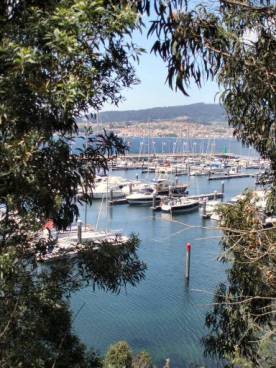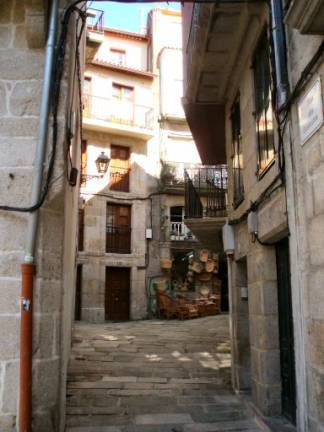Ria De Vigo & Illas Cies

26 – 30 April 2007: Ria De Vigo & Illas Cies
On leaving Porto Novo we initially headed for the Cies Islands which are a large nature reserve, but the wind had shifted to the wrong direction (why does it never follow the forecast around here?!) and there was a large swell running, making our planned anchorage in the north island uncomfortable and unsheltered. So we decided to hide in the Ria de Vigo until the bad weather passed, then nip out to the islands again later in the week.
Our first stop in the Ria de Vigo was a Cangas, a small town near the entrance on the north side of the harbour. As we turned into the harbour the wind built quite considerably, and we were swamped by the wake of a large fishing boat that passed rather too close for our likings. Unfortunately the window in our cabin wasn’t fully shut (as we rarely get water that far up the hull!), so most of the water found its way in and onto our bed. This meant that our first task in Cangas was to find a laundrette to get our duvet washed…
We anchored off the beach in Cangas, and went ashore in the dinghy. The edge of town where we landed wasn’t very nice, but as we approached the city centre the view improved a little. We explored most of what the town had to offer that afternoon (most of the sites of interest are out of town), and as we failed to find an open laundrette (it being a Friday afternoon on a holiday weekend), we decided to move on the following day. The anchorage wasn’t very comfortable either, with the wash from passing ferries and fishing boats constantly rocking the boat.


Rahula at anchor in Cangas James enjoying the peaceful anchorage in Cangas
The following morning we motored the 2 miles across the harbour to Vigo. Vigo has three marinas, and we chose to go to the one that was nearest to the centre of town. When we arrived we found the marina was packed, with barely room to turn the boat around, and no free pontoons. We went alongside the fuel pontoon to ask for a space and chatted to a very nice security guard who spoke good English while we waited for the marina staff to appear. Eventually the marina staff turned up, and despite all the efforts of the staff and the guard (including calling the club Commodore!) there was no space for us. So on recommendation we headed to Vigo’s newest marina on the eastern edge of the town.
The contrast was amazing. The second marina was empty, and had neatly spaced substantial pontoons with plenty of space to manoeuvre. We found a nice sheltered berth, and wondered why such a good marina was so empty when all the others in town were packed. The reasons soon became clear. Though the yacht facilities in the marina were faultless, the people facilities were terrible. The showers were in tiny porta-cabins right at the opposite end of the boatyard, and were filthy (the marina managers obviously assumed people would shower onboard their luxury yachts, so they didn’t need to look after the facilities). The nearest main road was a 15 minute walk up a steep hill, and then it was a 20 minute bus journey into the centre of town (though the staff did offer to get us a taxi). To top it all, this was the most expensive marina we had been to so far!


Punta Lagoa Marina,
Vigo. The city is in the background
of the right hand picture.
Vigo is the largest town we have been to since La Coruna, and is Spain’s chief fishing port. The wharves and quays stretch along the shore for nearly 5KM and the town has a long maritime history. So our first intended port of call was naturally the Sea Museum, which came highly recommended. The Tourist Information office was shut when we finally made it into town and rather than wait half an hour for it to open we examined the map in the window and found the Sea Museum. It looked like a nice walk along the coast to the museum, giving us a chance to take in some other sites along the way, so off we went (yet again all the warning signs were there but unheeded……J) . Unfortunately walking through Vigo without a map turned out not to be as easy as we expected, as the streets followed no logical pattern or the coast. We zigzagged across the city for 2 hours, walking through some less salubrious areas until eventually we chanced upon the museum. And you guessed it – it was shut. It was shut for the whole year for refurbishment. We were not happy!
Luckily there was a bus stop opposite the museum, so we got the bus back into the centre of town. On the way we passed a bike shop, and James insisted we got off the bus and went to have a look. Two bike shops later we had ordered 2 folding bikes for the boat, which will hopefully mark an end to our long walks searching for tourist attractions. Now we can get lost on long bike rides looking for elusive tourist sites!
The centre of Vigo is very nice, with interesting large buildings on wide main roads contrasting with narrow cobbled streets off the beaten track. There are random statues on display everywhere, and we came across a Cow Parade in one of the municipal parks. We also chanced across a very good (and free!) Tamara de Lampicka exhibition.


Vigo Architecture Contrasts


Vigo Cow Parade
There was a lot to do and see in Vigo, but we couldn’t stay in the expensive marina much longer, so we decided to move on and perhaps come back by bus from another place to explore Vigo. The gap in the weather meant it was time to go to the Illas Cies.
The sail there was plagued by light fluky winds from mainly astern and our preferred downwind sail (the ‘Drifter’) was out of action because it was showing some significant wear and tear which we wanted repaired before we broke it completely. The only option if we didn’t want to ‘hoist the aluminium mainsail’ (engine) was to break out the Spinnaker, which is quite unusual for short-handed cruising as it has a reputation for being a beast that is difficult to tame with heavy poles, uphauls and downhauls, hence we have put off using it for a long time. This is one area where we are obviously still in monohull mode as in reality, with a 20 foot wide boat there is no need for poles and the bits of string associated with them and rigging the beast took no longer than ten minutes and it flew beautifully for another ten minutes until the wind died completely. So the noise machine was switched on and we made our way towards the anchorage.

Passage under Spinnaker
The islands were once a refuge used by Sir Francis Drake when conducting pirate raids on Spanish shipping, and are now a nature reserve. They were our first taste of things to come when we explore the other Atlantic islands with beautiful white sandy beaches, glistening turquoise water and a rugged scenic terrain. We anchored off the beach and headed ashore to explore some of the many footpaths that crisscross the northern two islands.

Not the Caribbean but the Illas Cies, with Rahula in the distance
The weather still wasn’t great, and it looked like there was another storm coming towards us from the Atlantic. We only had time to do one of the walks on the islands, so we chose the longest one, which led to the lighthouse at the highest point on the islands. It was a pretty walk through woodland then a winding path led upwards along the cliffs to the lighthouse. At the top we had great views out to the ocean to the west and into the Ria de Vigo to the east. It was well worth the long climb, though the atmosphere was spoilt somewhat by a grungy Galician bagpiper insisting on making a racket (beard, sandals, look of deep spiritual searching on face, I think you know the type. But why must they always assume that their half arse attempts at music add so much to the ambiance, it was supposed to be a bird sanctuary but all but the hardiest shite-hawks were scared off because they believed a mass of angry cats were approaching!…J).

The long winding path up to the lighthouse
We would have loved to stay on the islands longer and visit some of the other anchorages or walk the other paths. Unfortunately the bad weather and the need for some sail repairs (must always go faster….J) before we head south into Portugal meant we had to move on. Though now we had an incentive to get all our jobs done quickly so that we could return to the islands one last time before it was definitely time to head south to greet our next visitor, my sister Eleanor, in Porto.